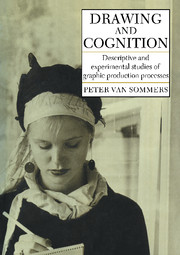Book contents
- Frontmatter
- Contents
- Preface
- 1 Basic executive constraints in drawing
- 2 Maintaining paper contact, anchoring, and planning
- 3 The reproduction of rectilinear figures
- 4 The production of curvilinear forms
- 5 The impact of meaning on executive strategies
- 6 Simple representational drawing
- 7 Difficult graphic tasks: A failure in perceptual analysis?
- 8 Stability and evolution in children's drawings
- 9 Innovations, primitives, contour, and space in children's drawings
- 10 Children's repeated drawings: How are innovations coded?
- 11 The pragmatics of everyday graphic production
- References
- Index
1 - Basic executive constraints in drawing
Published online by Cambridge University Press: 07 October 2011
- Frontmatter
- Contents
- Preface
- 1 Basic executive constraints in drawing
- 2 Maintaining paper contact, anchoring, and planning
- 3 The reproduction of rectilinear figures
- 4 The production of curvilinear forms
- 5 The impact of meaning on executive strategies
- 6 Simple representational drawing
- 7 Difficult graphic tasks: A failure in perceptual analysis?
- 8 Stability and evolution in children's drawings
- 9 Innovations, primitives, contour, and space in children's drawings
- 10 Children's repeated drawings: How are innovations coded?
- 11 The pragmatics of everyday graphic production
- References
- Index
Summary
“The multi-storied edifice”
One of the classical distinctions in the study of language has been that between its syntagmatic, or horizontal, organization and its paradigmatic, or vertical, structure. The syntagmatic dimension emphasizes the sequential structure of language forms. Its parallel in graphics is the sequence of production. The paradigmatic dimension of language deals with the fact that at any point in the sequence there is available a range of units or segments, the prototypical instance being the choice of word (“I,” “you,” “she”; “give,” “take”; “at,” “to,” “from”). In drawing we deal with the paradigmatic dimension when, for example, we consider which of a range of standard primitives (lines, circles, dots) are used in portraying parts of an object.
There is, however, another way of viewing the organization of these two systems, which is to consider language and graphics as layered systems wherein each action is or can be simultaneously structured or constrained at a great variety of levels. Hence the sound stream of speech carries multiple layers of organization, from the most biologically fixed qualities of the voice through all the phonological, syntactic, semantic, and pragmatic levels. If we choose the convenient starting point in language of the word, we can work down into its phonology, morphology, stress, tempo, the various stable and transient qualities of the voice used in its production; and we can work upward to its function in phrase, clause, sentence, its place in discourse, its social purpose, its multiple social contexts, its relation to gesture and other action.
- Type
- Chapter
- Information
- Drawing and CognitionDescriptive and Experimental Studies of Graphic Production Processes, pp. 1 - 29Publisher: Cambridge University PressPrint publication year: 1984



